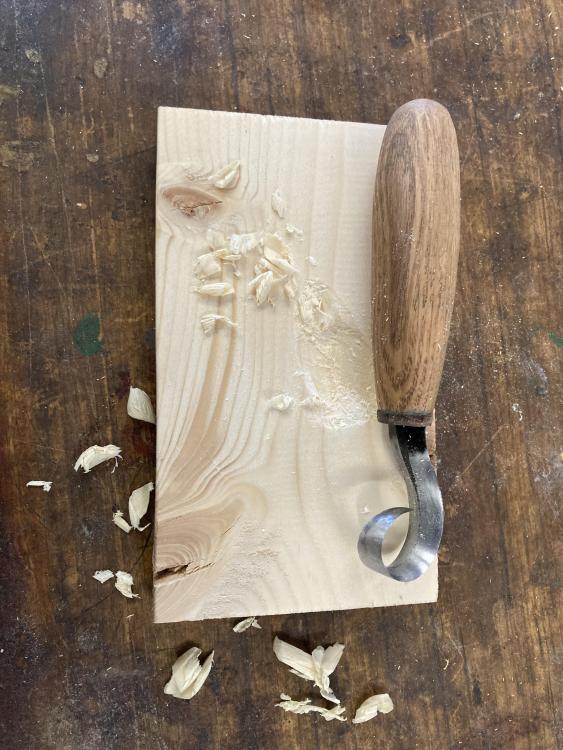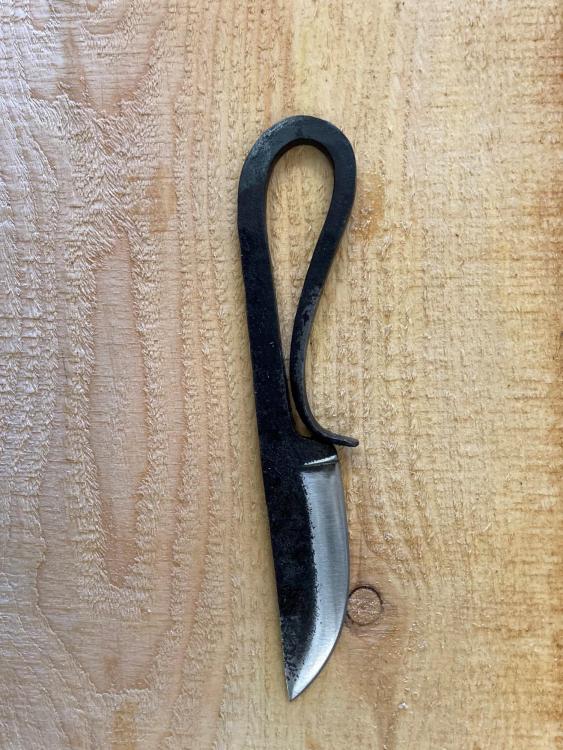-
Posts
124 -
Joined
-
Last visited
Content Type
Profiles
Forums
Articles
Gallery
Downloads
Events
Everything posted by gmbobnick
-

What's your latest blade look like? Post em and let us see.
gmbobnick replied to HondoWalker's topic in Knife Making
I really like it Randy. Nice clean lines. All around beautiful work -
George - Sometimes I feel part of a virtual coffee shop klatch trying to solve the world's problems.... Nevertheless, I am convinced that much of the confusion we see in people today is traceable to good seeds full of potential and value not given the what they need to grow by parents and those who could be teachers and mentors, but are as you say...too absorbed in their own pleasures. Meanwhile, the world plants weeds. There is sacrifice and dedication needed to keep order and virtue thriving. But fewer and fewer are on board. Just wanted to spread a word of encouragement to those with a passion to be productive and fruitful, such as is common among our blacksmithing brethren.
-
Ever wonder about how an apple was designed? The seeds are at the core and are surrounded by fleshy fruit…full of nourishment and moisture, protecting the seeds and providing a care package of water and nutrition. A seed might tenderly take root in the spring and form a sprout…protected by a mulch of leaves from the parent tree until it can stand on its own against the next winter. I think people and their purposes and passion function the same general way. Lifelong passions tend to go through phases that are analogous to that of a growing tree. First is drive to accomplish something or anything. It doesn’t need to be much so long as it delivers a sense of achievement… instilling the confidence “I can do this”. The seed sprouts. Second, there is a need to prove oneself capable. Nothing says that better than repetition of achievement. The tree grows to maturity. Next is desire for mastery. That is, to be at the top of one’s game and somewhere in the upper echelon of those with the same pursuit. The tree bears fruit. Then there is a need to mentor those just starting out, possibly motivated by gratefulness for our own opportunities, teachers, survival of near misses etc. The tree protects its progeny. Finally, if we live long enough and retain the energy, it’s about enjoying the process. The smells and sounds are savored. We can laugh and enjoy the circumstances. We can anticipate outcomes better and make them more valuable to others and to us. The tree stops bearing fruit, but still provides shade and weather protection through its broad canopy and strong trunk. But it all starts with a seed. Somehow against all the adversity and myriad obstacles, a seed of passion sprouted and grew for us. We all have our story. There is just something about this thing we chase after that thrills us deep in our soul, as it does for others too whether they yet know it or not. I believe that seed is often planted at a very early age. Yes the soil might be like a heritage in our blood that precedes the severed umbilical cord. But the sprout can either be nurtured or destroyed on that same soil. It’s a great responsibility for those who made it to the latter phases of their passion to plant seeds and help them grow and thrive. If the thing we are passionate about was worth doing for us and it delivered something useful for our kind in the eyes of our Creator, then it’s worth being careful to help the seed bear fruit in time for others as well. Patience and kindness are like water and fertilizer. Just a few thoughts.
-
As I understand it, which may well be erroneous, one can make "char" from substances that contains carbon...wood, coconut husks...coal? Yeah on the heavy metals...that worries me too. It wont take much to convince me it is better to get commercially produced activated carbon if I cant make something that is safe, even if not as effective as commercial stuff. Having fun learning something anyway. Thanks
-
Has anybody tried to make “activated carbon” from coal? Since this really isn't about blacksmithing, I wasn't sure of the best place to post the question. Yet, I think a blacksmith might have more of a pragmatic answer than some technical geek. From what I understand, this of course requires a source of carbon, plus cooking things to high temps (approximately 1000 degrees F). I understand that the process involves a phase of high heat absent of oxygen. There are other parts of the process I don’t understand very well, but am trying to learn. I literally have a ton of coal fines and have recently become interested in filtering rain water to drink. Activated carbon is useful in water treatment because of its tremendous surface area and the affinity of some contaminant chemicals for carbon. It occurred to me that I have a source of carbon and the ability to heat things to 1000 F…so then I have at least some of the resources. Just don’t know if the rest of the process is reasonably within reach. Thought I would check if any blacksmith out there have messed with this at all to help flatten the learning curve. Even if a knowledge-backed answer is “it’s not worth the trouble”, that would be helpful to me.
-
I also use one to dispense WD40, which I buy in a gallon can and WAY cheaper than by the spray can
-
It important to keep the piece as uniformly hot as possible, so setting it on the anvil or uneven application of cool oil causes problems with color uniformity. If the piece is too big to dunk in oil, I prefer to spray the oil. I get a much more even looking result that way. I use a "Sure Shot" sprayer. Its refillable and holds about a quart of oil. Various spray tips are available.
-

Which way to grind
gmbobnick replied to dickb's topic in Knife making Class General Class Discussion
I am still fairly low on the learning curve when it comes to grinding blades, but I will share one thing I have observed. With relatively low or insufficient belt tension, I think there is a tendency for the belt to bulge ahead of the blade. If grinding edge side up, there will come a time in blade sharpness where the belt will easily be cut. This might be more of an issue with woodworking sanders used for metal work. -
Just a funny story relating to aesthetics and professionalism Some years back I was visited by an architect (we engineers love to pick on them) who was dressed in all black, western style with enough silver ornamentation to deliver the sense that this man spent an inordinate amount of time and money on his daily wardrobe selection, and cared very much about aesthetics. He wanted help with a casino design and planned to start earthwork in 2 weeks. It was to look like a giant roulette wheel when viewed from the air, with an enormous “water feature” for the center pin. Come to find out he had not thought about an adequate water supply (domestic or artistic) or how to handle the large wastewater stream from such a building, and apparently missed the fact that roughly 6 months of the year the water feature would be inoperable due to freezing temps. Also, round structures are highly impractical to construct. Nonetheless, we helped get a workable plan set together and close to a year behind his schedule for obvious reasons. The bid came in twice his estimate. The solution? Cut the roulette wheel in half. So much for aesthetics, even though you’d never know from ground-level anyway.
-
I am an engineer and weighing in late on this conversation…only because I just now read the post. Anyway, to me being a “professional” has a lot more to do with demeanor and focus than dress, although appearance is certainly part of expressing professionalism. What I mean about demeanor and focus is that a professional knows precisely the boundaries of their expertise and works strictly and deftly within them. There is nothing like a good visual to emphasize a point, and for that I defer to the scene in Scent of Woman, where Pacino who plays a blind, ex-Marine Colonel is engaging a beautiful young woman and invites her to dance the tango in a fancy restaurant. He understands the physical and emotional boundaries of this engagement, and although blind presents himself convincingly as an experienced gentleman (“professional” if you will) and therefore trustworthy, who can guide her safely. She trusts him not to make her a fool while doing something new to her. Its a beautifully done scene. This is where a professional resides. Beyond the edge of the ordinary. Their clients just don’t know how to do a thing, but they trust the pro…hopefully not only because of how they appear, but instead because of how they understand what happens on the dance floor. Sadly, con-men know this principle all too well, and the world is full of them. Frauds of all kinds. If I want someone to castrate calves I don’t just look for someone wearing a cowboy hat. The know-how of a real cowboy is expressed by scarred, ape-hands and an air of horse sweat, and not words. So in answer to the OP, I would say that professionalism is a lot harder to pick out today than it was a generation or two ago, but the standards are still there and unchanged. I think the frauds, imposters, con-men - money-grabbers- are on the rise. We just need to be better at weeding them out.
-
Now that is funny! I got some splendid mental imagery from that one. Thanks Frosty
-
My best guess is its an odd piece of slag aggregate with an inclusion. It has a wee bit of iron because of the rusty color in the piece. Slag agg is common as parking lot gravel, especially near industrialized areas of Ohio. If the rest of the gravel is pretty uniformly colored, usually grey, possibly with some tiny bug-holes or open pores, that would be strong support for this conclusion.
-
Templehound, your knives are kind of paradoxical. They look ancient yet brand new. They say "use me with care" but look like they can handle heaps of abuse. They are common yet something that an aristocrat would gladly own. Its a style that I could instantly pick out in a crate of knives. It really is art. I enjoy seeing what you've done even if I don't comment on every post of yours. Thanks
-
The Village Blacksmith Henry Wadsworth Longfellow - 1807-1882 Under a spreading chestnut-tree The village smithy stands; The smith, a mighty man is he, With large and sinewy hands, And the muscles of his brawny arms Are strong as iron bands. His hair is crisp, and black, and long; His face is like the tan; His brow is wet with honest sweat, He earns whate'er he can, And looks the whole world in the face, For he owes not any man. Week in, week out, from morn till night, You can hear his bellows blow; You can hear him swing his heavy sledge, With measured beat and slow, Like a sexton ringing the village bell, When the evening sun is low. And children coming home from school Look in at the open door; They love to see the flaming forge, And hear the bellows roar, And catch the burning sparks that fly Like chaff from a threshing-floor. He goes on Sunday to the church, And sits among his boys; He hears the parson pray and preach, He hears his daughter's voice Singing in the village choir, And it makes his heart rejoice. It sounds to him like her mother's voice Singing in Paradise! He needs must think of her once more, How in the grave she lies; And with his hard, rough hand he wipes A tear out of his eyes. Toiling,—rejoicing,—sorrowing, Onward through life he goes; Each morning sees some task begin, Each evening sees it close; Something attempted, something done, Has earned a night's repose. Thanks, thanks to thee, my worthy friend, For the lesson thou hast taught! Thus at the flaming forge of life Our fortunes must be wrought; Thus on its sounding anvil shaped Each burning deed and thought. This poem is in the public domain.
-
Those look like planer blades.
-

What's your latest blade look like? Post em and let us see.
gmbobnick replied to HondoWalker's topic in Knife Making
I got the edge butter knife thin, flat on one side and beveled both ways on the other. Then rolled it flat side out. It was 1084 steel. After figuring out what color wouldn’t stick to a magnet, I danced it around the edge of the burner blast until it was even color then quenched. Just work the flat side on flat sandpaper to sharpen. Learning as I go. But so far seems good. -

What's your latest blade look like? Post em and let us see.
gmbobnick replied to HondoWalker's topic in Knife Making
-

What's your latest blade look like? Post em and let us see.
gmbobnick replied to HondoWalker's topic in Knife Making
SHC, Thanks for asking. I don't think I can claim any originality, yet I don't know where or how I got the idea either. I will say that careful placement of the copper rivet does wonders for a tight fit...or for that matter, rendering the thing useless for the intended blade if not careful. Let us see how yours comes out! -

What's your latest blade look like? Post em and let us see.
gmbobnick replied to HondoWalker's topic in Knife Making
-

What's your latest blade look like? Post em and let us see.
gmbobnick replied to HondoWalker's topic in Knife Making
Tried my hand at ye olde blacksmith knife. Made it from a piece of leaf spring that my neighbor gave me. Came our fair I suppose and neighbor gets part of his spring back as a knife. Should work fine for cutting bale twine anyway. -
I am on the same page as JHCC. Making a point usually competes poorly with the listener’s focus on judging the speaker. Tactics are necessary to prevail over judgmental musing.
-

What do you listen to while working
gmbobnick replied to SinDoc's topic in Blacksmithing, General Discussion
What a funny thought this post triggered when I thought about my honest answer to the question…”what do you listen to in the forge?” Except in a very few circumstances, I do not block out ambient noise with music or the like. I feel vulnerable then. I want to know what is happening around me, especially imminent trouble, and sound is a huge clue. I don’t keep a phone in my forge either. I make those troubles wait. It’s the troubles close at hand that concern me. Sometimes I have a radio (aka walky-talky…at the risk of sounding like an old person) so the wife can reach me and doesn’t become overly annoyed by yelling out of the house window. When the radio battery is dead or I forgot to bring it, I am always mindful of that certain high pitched screechy sound amid the cacophony of forge jangle. Now what’s funny is my wife keeps a bunch of chickens. There has been several times that I dashed out of shop with tongs and hot steel in hand because of a certain similar pitch emitted from a chicken instead of my wife. One exception to not listening to music while working is when I am raking hay. I love raking hay. I can feel the tractor through my xxxx and know by that if there is trouble, and hay rakes are relatively trouble free, and nobody expects to be heard while I am on a tractor. Then I listen to music. -
Thanks all for the excellent information!
-
Made a hook that I think follows Frosty's description. I used a 15" long piece of 1/2" round mild, 1/4"x1"x10" of flat bar, and 1-1/8"x4" oak dowel. The chisel divot is a good idea. Hadn't heard that one before. I used a tapered square punch instead, driven in just far enough to leave four good notches. The hot peened end of the tenon got a bit wonky. Next time I will probably use a 3/8" rod to hold the handle, peened at both ends, or maybe something with a little more old-style look than hex nuts. So some improvements are in order, but otherwise, I think this meets all my goals. Thanks Frosty and the others who chimed in with ideas. Well at least this time I asked for input.
-
Its functional (I just got thru my first cutting of hay). I just don't like the comfort with my design. Might try a bit thinner shaft below the handle. Yes, that is plenty simple and I am sure it works ok. I want a fatter handle though. Would like to use wood.



